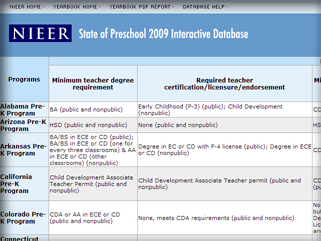
By the Book
Approaches to Curriculum in State Pre-K Programs
June 28, 2010
There is no simple answer to the question of what, and how, preschoolers should be taught. The 51 state-funded preschool programs profiled in The State of Preschool 2009 Yearbook present a wide range of program interests and state priorities, and this continues to be true in the realm of curriculum.
Thirty-three prekindergarten programs in 26 states have no state-approved comprehensive curricula. Of the states with approved comprehensive curricula, most give programs a number of options to choose from; each program with approved curricula offers at least two curriculum options. Some well-known curricula are more
widely used than others. Of the 18 programs specifying comprehensive curriculum, all programs allow the use Creative Curriculum and all but two have approved HighScope. Additionally, seven programs allow the use of Montessori; seven use Curiosity Corner; five use Bank Street; four allow High Reach; three use Tools of the Mind; and one program allows the use of Reggio Emilia. Eleven programs offer other alternative curriculum options.
Fewer states make provision for subject-specific preschool curriculum; only five programs have state-approved subject-specific curricula. Rather than mandating the use of a particular curriculum as seen with comprehensive curricula, most programs with approved curricula require aligning them with state standards or require a focus on particular domains.
To see the state-approved curriculum policies in your state, click on the image below. For complete information on state-funded prekindergarten programs, see the 2009 Yearbook Interactive Database.
For more information about preschool curricula please refer to the NIEER policy brief Preschool Curriculum Decision Making: Dimensions to Consider by Ellen Frede and Debra J. Ackerman. Below is a checklist from the brief of things to consider when selecting a curriculum:
1. How does the curriculum define the roles of the teacher and the child in the learning process?
2. What domains of learning are addressed? Are they integrated or treated separately? Will the curriculum lead to achievement of state early learning standards?
3. Does the curriculum provide guidance for differentiating teaching for students with special behavior, linguistic, or learning needs?
4. Do the curriculum’s developers provide an assessment system that is consistent with the teaching philosophy and learning content?
5. What research evidence exists to support the value or effectiveness of the curriculum?
6. Is the curriculum appropriate for all teachers, regardless of their qualifications? What kind of professional development is provided?
7. Are specific materials required to implement the curriculum?
8. Does the curriculum model provide guidance for such services as parent involvement and the transition to kindergarten?
– Megan Carolan, Policy Research Coordinator, NIEER
– Dale Epstein, Assistant Research Professor, NIEER

About NIEER
The National Institute for Early Education Research (NIEER) at the Graduate School of Education, Rutgers University, New Brunswick, NJ, conducts and disseminates independent research and analysis to inform early childhood education policy.
